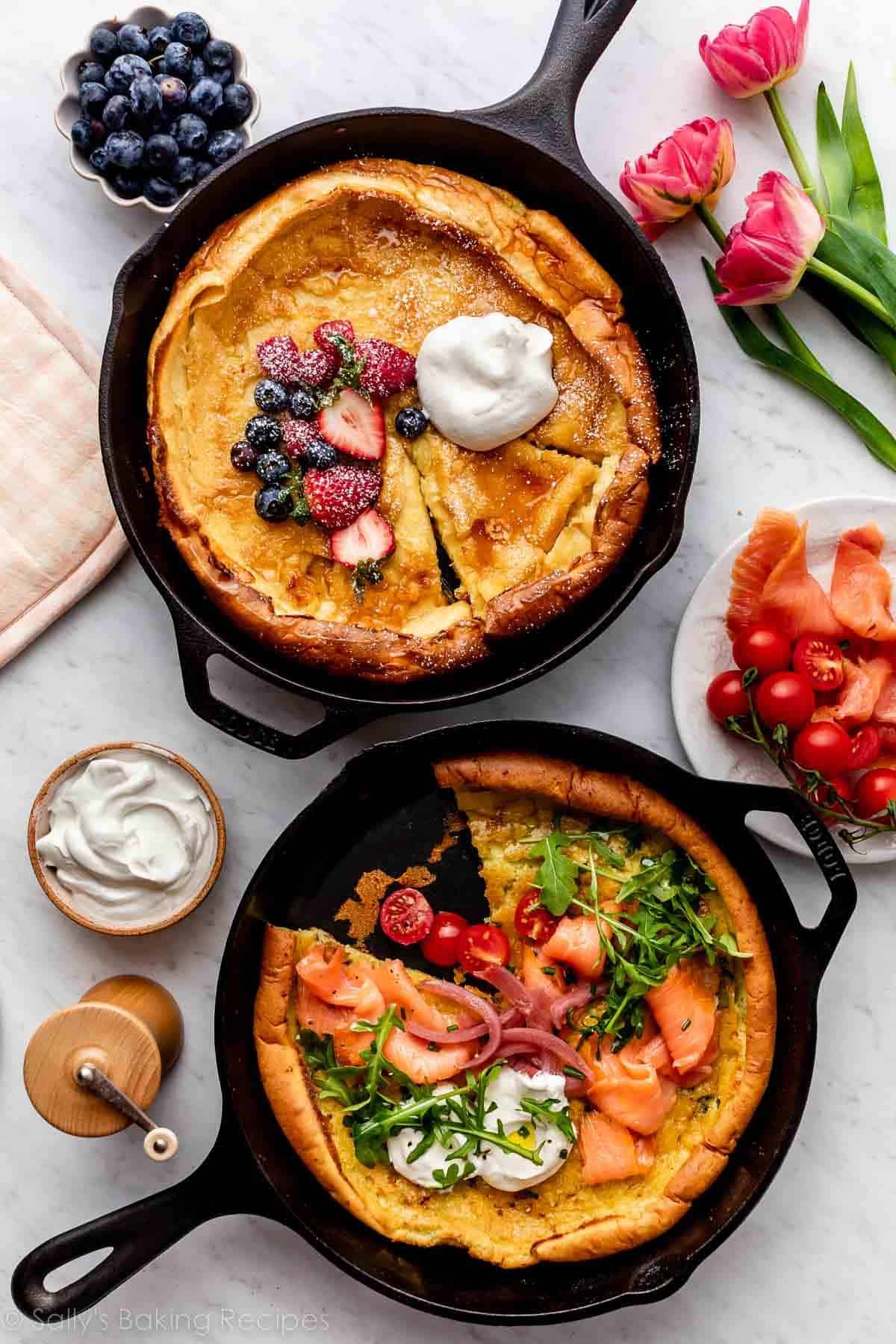What Is a Dutch Baby Pancake?
A Dutch baby pancake is an impressive-looking (but actually very easy!) type of pancake baked in a skillet. It originated in Seattle at a cafe called Manca’s and may have been derived from Pfannkuchen (German pancakes). The batter puffs up like a balloon in the hot oven, then collapses down when you take it out. One reader, Carie, commented: “My 12-year-old son and I enjoyed making this fun and interesting recipe! He loved the drama of the puffy pancake that then settled into the perfect “bowl” for our toppings. The recipe is accessible to all skill levels and yields great results! We will be making this again. ★★★★★” The taste and texture is sort of a cross between a Yorkshire pudding or popover and a crepe: slightly sweet eggy pancake, with crisp edges and a tender middle. This makes a great base for tons of topping options and combinations—sweet as well as savory. I’ve included my two favorite ways to top it in the recipe below, but have fun discovering your own favorite version! While it’s typically thought of as a breakfast or brunch dish (and would be a perfect Mother’s Day recipe if you’d like to make someone a special breakfast), Dutch baby pancakes can really be enjoyed any time of day!
Here’s Why You’ll Love It:
Easy to make, but looks super impressive Crispy buttery edges, tender center Just 8 simple ingredients Your blender and oven do most of the work—no standing over the stove and no flipping Versatile—makes a fantastic canvas for your flavor artistry!
Let Me Show You How to Make a Dutch Baby Pancake:
The batter is a snap to make with a blender, just like how we make crepes. Start by blending 3 eggs until they’re foamy and fluffy (takes less than a minute): Then add flour, milk, lemon zest, sugar, salt, and vanilla. Purpose of these ingredients: While the eggs, flour, and milk make up the bulk of this batter, be sure to include the flavor-enhancing ingredients of lemon zest, sugar, salt, and vanilla. Without those, the overall flavor would taste pretty bland. If you don’t have a lemon you can zest, you could use cinnamon instead, for a different flavor. Blend to combine all the ingredients, then let the batter rest for 15–20 minutes before baking. This rest is key, because it allows the flour to soak up some of the liquid and slightly thicken the batter:
What Pan Do I Use for Dutch Baby Pancakes?
I use this cast-iron skillet, which is the same one I use for frittata and this asiago-crusted skillet bread. You can use any oven-safe skillet this size, though. If you don’t have a 10-inch oven-safe skillet, you can use any 3-quart size baking dish, a 10-inch pie dish, or 9-inch square baking pan instead. Melt butter in the oven in your pan, and then pour the batter into the hot pan. Bake for 15 minutes at a high temperature, to really lift the Dutch baby pancake up nice and high, then reduce the temperature and bake for another 10 minutes. Unlike with most American pancake recipes, there’s no leavening agent in Dutch baby pancakes. All the height comes from the eggs and from the steam lifting up the batter in the hot oven. Like a souffle, this batter rises high when baking, then falls when cooling. Success Tip: Room temperature batter will puff up quicker in the oven, giving the pancake more height. So, use room temperature eggs and milk. When it’s done baking, watch the magic of the puffy pancake pillow settling down into its final form—now it’s a beautiful bed ready for your toppings!
Sweet or Savory Dutch Baby Pancake
My favorite way to enjoy a sweet Dutch baby is with a dusting of confectioners’ sugar, a drizzle of maple syrup, and some fresh berries (whipped cream and strawberry sauce take it to another level!). But I am also a big fan of savory Dutch baby pancakes… especially when we are talking smoked salmon and herbs. You can find the details for how to make the sour cream and chive Dutch baby pancake pictured here in the Notes section beneath the recipe instructions.
Big List of Dutch Baby Topping Ideas
Can I Make the Batter Ahead of Time?
Though it’s a very quick batter to whip up, you can certainly prep it ahead of time. After blending it, you can cover and refrigerate the batter for up to 24 hours before using. There’s no need to bring it to room temperature before baking.









